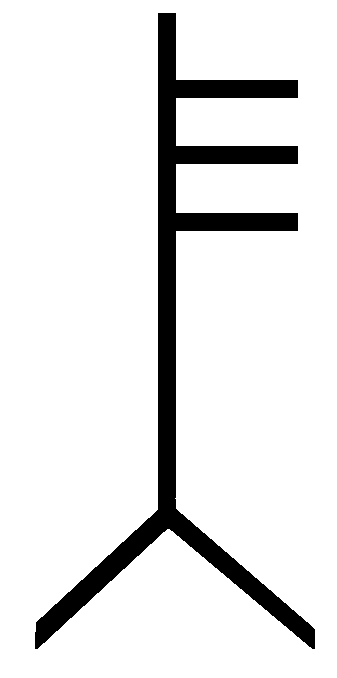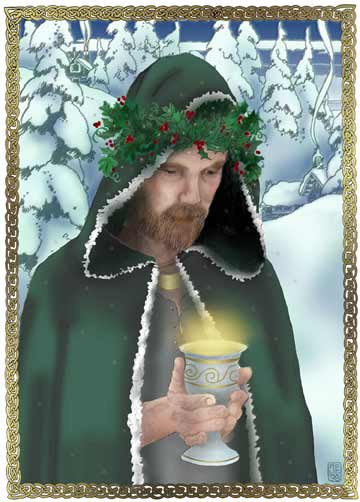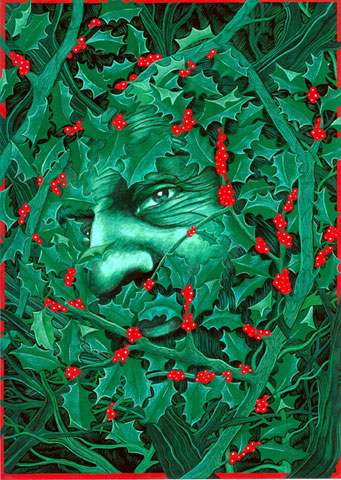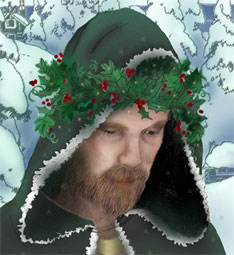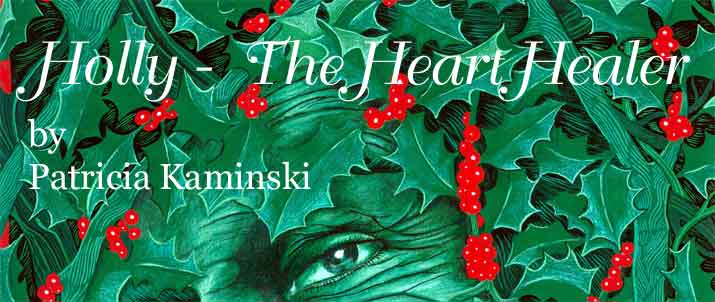
|
A Lineage of Celtic Wisdom Dr. Bach regarded Holly as one of the two most primary flower essences in all of his repertory. While the Wild Oat is used in a fundamental way to give the soul its orientation to the outer world, the Holly is regarded as the most universally applicable of essences to heal the inner being and to stimulate the basic loving nature of the human soul. Holly should be considered not only as a remedy to administer in specific therapeutic situations, but also as a threshold essence for anyone wishing to advance in flower essence therapy.
It is during June that the light of the sun reaches its culmination, and then begins its descent into earth. The Holly speaks to the fierce capacity of the human soul to take the descent into the underworld, bringing inner light into darkness. Thus we can understand the signature of the tree, with its ability to germinate without sunlight, favoring dark, moist conditions that are more strongly related to the downward earth pole. Its stiff, pointed leaves are not unlike thorns or "spears." The Holly yields a hard, white close-grained wood that imparts a quality of solidity and impermeability, as it stands in the depths of winter, impervious to cold and darkness with its somber evergreen color. Of all the trees in the Ogham, the Holly and the Oak are most primordial—they are viewed as two "kings" who exchange leadership on a yearly basis by engaging in symbolic battle. The Gaelic name for Holly—Tinne—is related to the word, tanist, meaning "dark twin." The Oak King rules from the time the light begins its ascent in December until the summer solstice in June. Holly is the "dark twin" who reigns during the waning light of the year, until winter solstice.
Holly King by Joanna Powell Colbert. Used with permission by artist Christmas - An Awakening of the Heart In popular culture, we relate to the Holly most vividly during the Christmas season. With its cheerful red berries and green foliage, we "deck the halls with boughs of Holly." Unfortunately, our relationship to this plant is mostly unconscious and largely sentimental. The Holly's prominence at Christmas is actually meant to represent a culminating experience within the soul life. It is an awakening of the love forces of the heart achieved through a descent into the interior of the self and the earth that comes to fruition during this festival. This understanding is depicted in Rudolf Steiner's Calendar of the Soul. Steiner is a modern initiate who incorporated the mystery streams of earlier cultures, including Druidic wisdom. His calendar is a series of 52 runic verses for each week of the year. Beginning at summer solstice, the soul gradually finds its way into an interior reality, moving out of the great cosmic heights. The sense of self coalesces like a seed, with light working into the inmost being, as a purifying and strengthening force. Then, at winter solstice, this light is quickened and shines forth from the heart chakra:
In subsequent winter verses Steiner describes this activity of the soul as a "heart-high gladness". It is the inner light of Self-containment gained by living in "spirit depths"—at one with the "world ground." The soul is so solidly secure and anchored within itself that nothing can assail one's sense of deep peace. When this consciousness is mastered, the journey inward of the Self is complete. The heart awakens with a streaming of love, gradually seeking its way outward into the sense world again to meet the expansive forces of the light in spring and summer. We could say that the Holly flower which blooms in outer nature in late spring/summer, blossoms again in the human heart during winter as a force of love. Its nature is a sun force that lives, not in the heights but in the depths of the earth. The capacity of the flowering Holly heart is the profound intention of the Holly flower essence developed by Dr. Bach. In describing the Holly flower essence, Dr. Bach wrote, "The ultimate conquest of all will be through love and gentleness, and when we have sufficiently developed these two qualities nothing will be able to assail us, since we shall ever have compassion and not offer resistance." Mechild Scheffer, writing in the Encyclopedia of Bach Flower Therapy, characterizes the Holly as "the heart opening flower," one that helps the individual to "live within the stream of love." Like all flower essences Holly addresses a tension of opposites, a seeming paradox for the soul. With its thorny leaves and harsh ability to live in the world, the Druidic glyph for Holly proclaims "I am a battle-waging spear." But this hostility is turned outward into the world when the soul is not secure in itself and has not mastered fierceness as a fire within the soul. Unless the Self is fortified from within, we do not meet the outer world in the right way. We respond with hostility, envy or jealousy. This is why Dr. Bach grouped the Holly with those remedies for "oversensitivity to ideas and influences." The Holly gives a strength of Self that becomes the very basis of compassion. The Green Knight - A Solitary Branch of Holly Holly's paradoxical teaching of harshness and holiness, is also found in the Arthurian legend of Sir Gawain and the Green Knight. The Green Knight appears in Arthur's court during a Midwinter Feast:
The Green Knight is a manifestation of the Green Man —the vast cosmic forces of Nature that must be encountered by the human soul and anchored by the human heart. Bearing a holly branch in one hand and an axe in the other hand, the Green Knight challenges one of Arthur's knights to cut off his head with the axe. He declares, "If you cut off my head, you must meet me in the Green Chapel of the Northland, where I will return the blow to you."
Gawain is a knight of great valour, though he is also driven by courtly intrigues, ambitions and desires. He accepts the challenge and severs the Green Knight's head. Over the course of the year he travels disoriented through a desolate winter landscape in search of the Green Chapel. In the course of this quest, he is tempted by a woman who is actually the Green Knight's wife in disguise. Gawain emerges from these encounters with a pure heart and finally finds the place where the Green Knight lives: "A cleft between two steep cliff faces where trees were growing deep green even in winter." It is here in the land of the Holly trees that Gawain encounters the Green Knight, surviving his blows intact. Heigh Ho the Green Holly The idea that Holly heals the vexations of the human heart, is also addressed by Shakespeare in his play, As You Like It. Its main theme involves a banished duke who retreats to the Forest of Arden far away from his mean-spirited brother, proclaiming:
The forces of Nature work as a nurturing balm in the play, until eventually the wicked Duke Frederick is healed by a holy hermit of the forest and all social relationships are brought back to harmony. One of the key songs, Blow, Blow Thou Winter Wind sings of the fierce forces of winter, which are "not so unkind as man's ingratitude." Its refrain is:
The Holly Bears the Crown Holly stimulates the loving capacities of the heart by developing what Dr. Bach called "that great inner Self." Perhaps the most profound archetypal picture of Holly is evoked through its symbolism as the Crown of Thorns. As the traditional Christmas carol proclaims, Of all the trees that are in the wood, the holly bears the crown. Druid priests wore Holly in their hair while collecting the sacred mistletoe medicine in the winter, Holly was also worn as a crown to represent the Holly King in seasonal festivals. The Holly Crown was a sign of deepest respect and recognition that such an initiate had mastered the forces of nature in harmony with the human soul.
In Roman culture this knowledge had already
degenerated considerably, though external remnants of these
rituals were carried forth in such feasts as the winter Saturnalia.
The Roman court feared the powerful spiritual nature of Jesus
Christ, while at the same time mocking and disregarding him:
This archetypal picture of Christ who is crowned with thorns can stir the depths of our being. For it is the Christ who bears in his heart the most perfected forces of a divine love, that is at the same time human love. The Christ force, born in the depths of the earth at the midnight hour of Christmas, shines forth as the essence of love in the human heart:
It is no small irony when Christ is presented wearing a crown of thorns and a kingly robe:
Pilate does not say behold the king, but rather behold the man. These words spoken unconsciously by Pilate are actually of the deepest truth. The kingly crown typically elevates one to a higher status by activating the crown chakra. But the crown of thorns works in the reverse way in the Christ being. It is a crown that makes the head bleed, bringing the high spiritual essence into the human heart. The divine becomes human, the king becomes man in Christ. He is called the Son of Man, for Christ is the bearer of all that becomes human through the force of love in the heart. The Holly tree came to be known as Christ-Thorn in middle Europe, for it was recognized that this plant spoke to the archetypal reality of the Crown of Thorns as a soul initiation. Dr. Bach characterizes one who needs Holly saying, "within themselves they suffer much, often when there is no real cause of their unhappiness." This existential pain of feeling unloved leads to emotions of jealousy, envy, hostility and anger. Like the Green Knight and Gawain, who exchange blows to the head, in order that consciousness be transformed, the Crown of Thorns is also a kind of "beheading." The false self must be pressed down with a Crown of Thorns until it finds a deeper truth in the human heart. The "battle waging spear" is thrust not outside, but within. Holly teaches us that we cannot find love outside ourselves, if it is not anchored from within the human heart. Holly creates what is divine from within what is human. Holly helps the human heart know its own wholeness; its own holiness. References As You Like It (Oxford School Shakespeare Series) by William Shakespeare, Roma Gill (Editor) British Folklore, Myths and Legends by Marc Alexander, Weidenfeld and Nicolson; ISBN: 0297781510 The Celtic Lunar Zodiac by Helena Paterson, Charles Tuttle Company, Inc. Celtic Lore: The History of the Druids and Their Timeless Traditions by Ward Rutherford, Thorsons Pub; ISBN: 1855381346 Celtic Tree Mysteries: Practical Druid Magic and Divination by Steve Blamires, Llewellyn Publications; ISBN: 1567180701 Collected Writings of Edward Bach ed. by Julian Barnard, Ashgrove Press Limited, Bath; ISBN: 1853980730 The Druids: Celtic Priests of Nature by Jean Markale, Jon Graham (translator), Inner Traditions Int'l. Ltd; ISBN: 0892817038 A Druid's Herbal for the Sacred Earth Year by Ellen Evert Hopman, Inner Traditions Int'l. Ltd; ISBN: 0892815019 The Encyclopedia of Bach Flower Therapy by Mechthild Scheffer, Inner Traditions Int'l. Ltd; ISBN: 0892819413 The Healing Herbs of Edward Bach by Julian & Martine Barnard, Ashgrove Press Limited, Bath; ISBN: 1853980862 The Illustrated Calendar of the Soul by Rudolf Steiner, Temple Lodge Publishing, London; ISBN: 1902636066 Myths & Legends of the British Isles by Richard Barber (editor), Boydell & Brewer; ISBN: 0851157483 The Quest for the Green Man by John Matthews, Quest Books, Wheaton, Illinois Sir Gawain and the Green Knight and French Arthurian Romance by Ad Putter, Clarendon Press ISBN: 0198182538 Sir Gawain and the Green Knight; A Middle-English Arthurian Romance Retold in Modern Prose by Jessie Laidlay Weston, Editor Sir Gawain and the Green Knight Pearl Sir by J.R.R. Tolkien, Houghton Mifflin Co., ISBN: 0395264693 Tree Wisdom by Jacqueline Memory Paterson, Thorsons Pub; ISBN: 0722534086
|

To install this Web App in your iPhone/iPad press ![]() and then Add to Home Screen.
and then Add to Home Screen.
